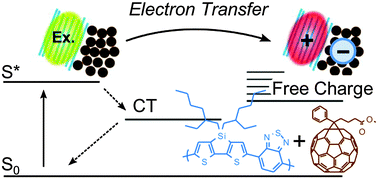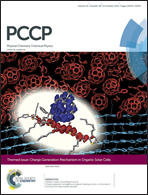Charge-carrier generation in organic solar cells using crystalline donor polymers†
Abstract
Charge generation and recombination dynamics in a blend film of a crystalline low-bandgap polymer, poly[(4,4-bis(2-ethylhexyl)dithieno[3,2-b:2′,3′-d]silole)-2,6-diyl-alt-(4,7-bis(2-thienyl)-2,1,3-benzothiadiazole)-4,7-diyl] (PSBTBT), and [6,6]-phenyl-C61-butyric acid methyl ester (PCBM) were studied by transient absorption spectroscopy. Upon photoexcitation of the PSBTBT absorption band at 800 nm, singlet excitons were promptly generated, and then rapidly converted into polarons in a few picoseconds. We found that there are two different polarons in PSBTBT: one is ascribed to polarons generated in the disorder phase and the other is ascribed to polarons in the crystalline phase. On a time scale of nanoseconds, ∼50% of polarons in the disorder phase recombined geminately to the ground state. On the other hand, such geminate recombination was negligible for polarons in the crystalline phase. As a result, the overall charge dissociation efficiency is as high as ∼75% for PSBTBT/PCBM blend films. On the basis of these analyses, we discuss the role of polymer crystallinity in the charge-carrier generation in organic solar cells.

- This article is part of the themed collection: Charge Generation Mechanism in Organic Solar Cells

 Please wait while we load your content...
Please wait while we load your content...